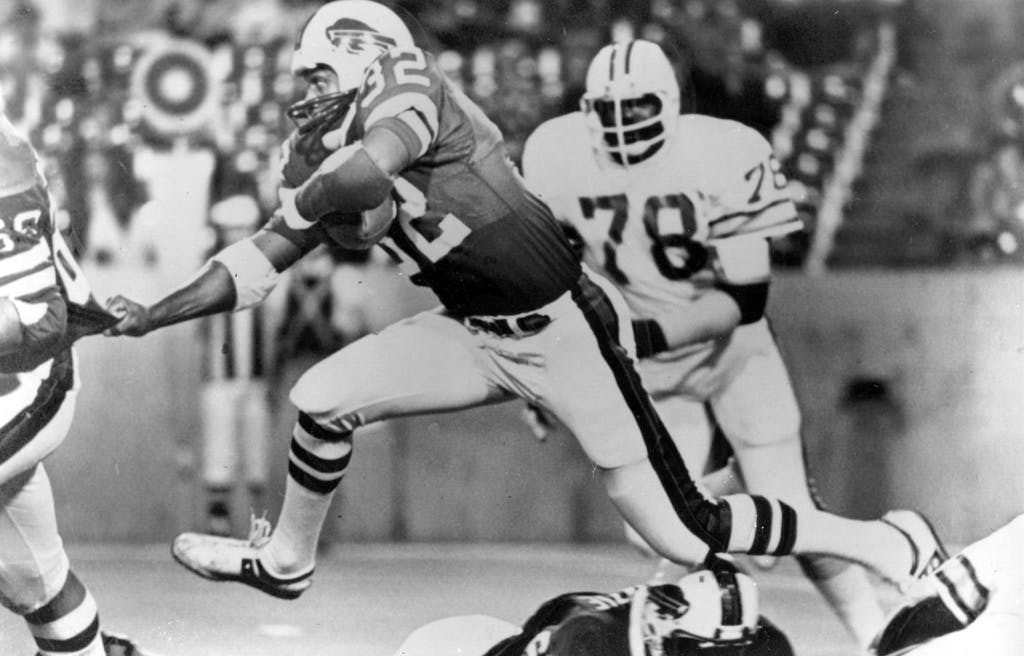Before He Was a Criminal, O.J. Was a Master of the Gridiron Like No Other
The way he ran the football was magical, eluding defenders, streaking past baffled tacklers, and mesmerizing everyone with his brilliance. His feet never seemed to touch the ground.

Like perhaps many young teenage boys in the early 1970s, my football hero was O.J. Simpson. When he became the first running back in the National Football League to rush for more than 2,000 yards in 1973, I cut out the Sports Illustrated article and glued it into my scrapbook, which otherwise was all about me.
The way he ran the football was magical, eluding defenders, streaking past baffled tacklers, and mesmerizing everyone with his brilliance. Heck, his feet never seemed to touch the ground.
The Juice and the Electric Company was the nickname for O.J. and the Buffalo Bills offense in 1973, the year he set an NFL record by rushing for 2,003 yards. His lineman carried him off a cold Shea Stadium field after he destroyed the Jets for 200 yards and a touchdown in the final game of a 14-game season where he averaged 6.03 yards per carry. On top of his teammates’ shoulders, he was on top of the world.
“I was part of the history of the game,” he said years later, according to the Associated Press. “If I did nothing else in my life, I’d made my mark.”
Of course, Simpson, who died on April 10 at age 76 after a battle with prostate cancer, did a lot more, which made him more infamous than famous.
For me, his fall from grace happened a few years before he was charged with murdering his ex-wife, Nicole Brown Simpson, and her friend, Ronald Goldman, in June 1994 in Los Angeles. After a lengthy trial, a jury found him not guilty in a dramatic case that was more about race and misconduct by the Los Angeles Police Department than it was about who butchered Nicole Simpson and Ronald Goldman with a knife.
Years before that, I was in my first season as a reporter covering the New York Giants when Simpson, then a television broadcaster, visited the team in East Rutherford, New Jersey to preview a game and found his way to the toilet in the media room in the bowels of Giants Stadium.
“There’s O.J. freakin’ Simpson,” I thought to myself, hoping to get a wave or some acknowledgement. Instead, he ignored all 20 people in the room and went about his business, so to speak. We were invisible.
Months later at a Super Bowl party, I saw him again and politely asked for an autograph. He wrote his name and turned his head as he handed me his scribble. That’s when he went from hero to zero in my eyes.
Not long after that, the world watched him on live television being chased by the Los Angeles Police Department while riding in a white Ford Bronco. Then we witnessed the “Trial of the Century,” which launched reality television. Though he was found not guilty in October 1995, public opinion found him guilty.
No longer a football hero, many rejoiced when his ego and sense of entitlement caused him to partner with men with guns and rob two sports memorabilia dealers in a Las Vegas Hotel room. The court system didn’t whiff at a second opportunity, and in 2008, at age 61, he began serving nine years of a 33-year sentence in a northern Nevada prison.
His fall from grace was stunning. The football hero, Hollywood actor, broadcaster, and rental car pitchman became persona non grata.
Today, only aging baby boomers, remember that, at one time, he was the best football player on the planet. He won the Heisman Trophy in 1968 as a two-time All-American at the University of Southern California. He was taken first overall by the Buffalo Bills, who won one game the year before his arrival.
It took three mediocre seasons before the Bills put together an offensive line worthy of his talent. He gained 1,251 yards in 1972, followed by his record-setting season in 1973. He was named the NFL’s Most Valuable Player that season and followed that with 4,445 rushing yards and 27 touchdowns over the next three years. Off the field, he avoided taking a stance on civil rights issues and flashed his smile enough to create an image that put White America at ease.
A knee injury in 1977 limited him to just seven games. The next year, he was traded to the San Francisco 49ers, where he hobbled through two seasons totaling just 1,053 yards before retiring.
His career was celebrated in 1985 when he was inducted into the Pro Football Hall of Fame in his first year of eligibility. His resume included his MVP award, six Pro Bowl appearances when the Pro Bowl meant something, and five All-Pro honors. He finished his career with 11,236 yards rushing, second only to the great Jim Brown at the time. Mr. Simpson led the NFL in rushing four times when having a star running back was crucial to a team’s success.
His death began trending on social media as soon as his family confirmed his passing, a digital storm containing all types of tweets fixated on events that shattered his legacy after June 12, 1994. A man who once danced through defenses and was cheered by thousands long ago buried his greatness on the field by his actions off of it.

